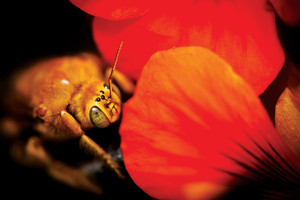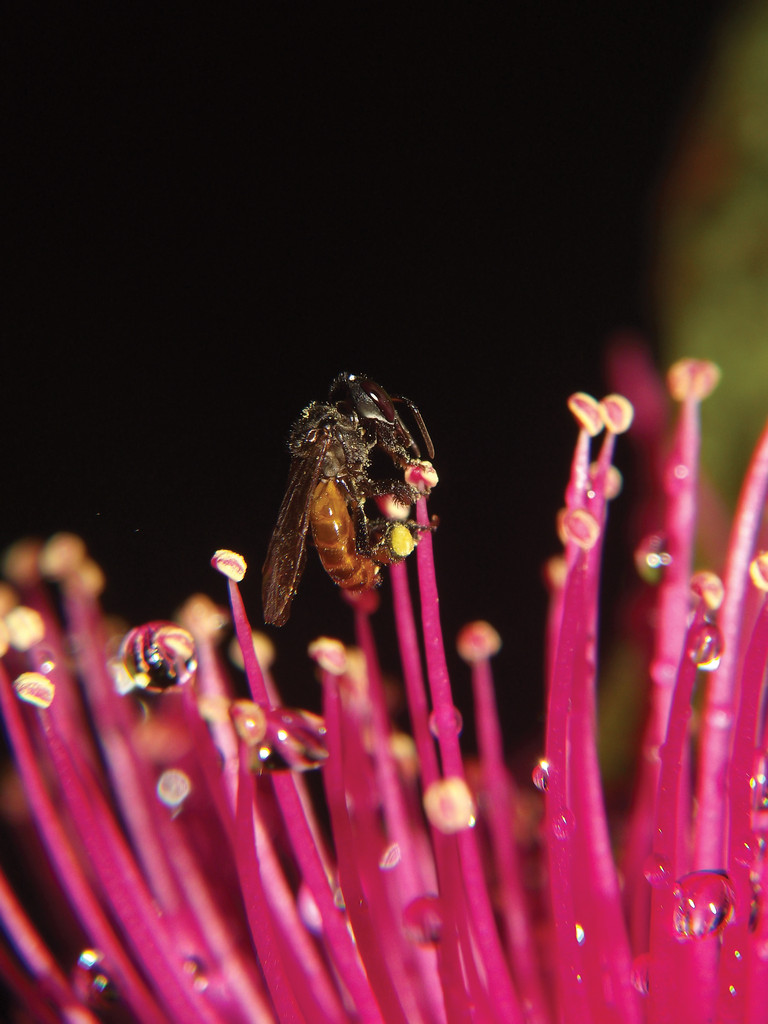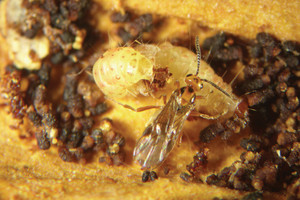
Bumblebee nests of native bee should be available in the coming months to sell passion fruit producers
Companies develop insect breeding methods to combat pests and pollination
When present in the plantation, this bee increases the number of fruit in the passion fruit through pollination. The bugs are still being produced in pilot scale by the company Florilegus, from Sao Paulo, which began its activities in 2013 in order to produce and sell bumblebee nests of species of the genus Xylocopa. "In many countries, people and governments are mobilizing to increase the presence of pollinators, essential in the agricultural production chain, which are often affected by the intensive use of pesticides in agriculture ", explica to zootecnista Paola Marchi, fundadora give Florilegus. "Brazil, for example, It is one of the largest producers of passion fruit and the presence of large bee, as carpenter, It is essential because not pollinated flowers do not bear fruit. These bees are increasingly scarce in crops and there is a growing demand for pollination services ", diz.Os producers may purchase nests containing the newly emerged insects, which can be released in flowering in crops. "Proper amount per area and time indicated in permanent crops are still being adjusted", Paola counts. What is known is that this species often reuse their old nests and, that is why, can remain in the areas cultivated with passion for generations. But for this there must be adequate conditions for their survival, as the existence of other plants from which they can collect pollen, Fonte protein, because the passion fruit flowers provide nectar she just, which is the source of energy.
To develop the creative technology of carpenter bees, the researcher studying reproductive aspects of these insects, the ability of females to generate descendants. "Besides that, storage and immature individuals incubation period being tested at different temperatures to predict the appearance and handle of bumblebees ", says Paola. "We are developing and perfecting techniques to multiply the nests, as well as transport and installation in the crops. "
In another company, a Promip, Engineer Coelho, the Metropolitan Region of Campinas, It is developing a technology for creating native bees for pollination. It's kind stingless, known as mandaguari (Scaptotrigona shaved), who lives in colonies and can pollinate crops such as strawberry, tomato and coffee, for example. "We started the project in 2010", account the founding partner Marcelo Poletti. "It was divided into three stages: Mass production laboratory evaluation, insects compatibility study of the chemicals used in agriculture and effectiveness in the field. We are in the final phase and should start selling the nests in 2016. "
What Promip already have on the market are three species of predatory mites (which are not insects, but arachnids like spiders and ticks) microscopic, used in biological pest control. Two species, a Phytoseiulus macropilis and the Neoseiulus californicus, fight another type of mite, brindle (Tetranychus urticae), causing damage to vegetables, fruit, flowers and other crops. The third, Stratiolaelaps scimitus, It is used in the control of fungus gnats (Bradysia matogrossensis). Even with that name, It is an insect that eats and fungi attack the roots of various cultures, especially during the formation of the seedlings. "We produce about 100 million people a month these three species in our biofactory ", informs Poletti. "They are sold to producers and retailers."
Well established in the market is Bug, Piracicaba company, creating four species of small wasps parasitoids, Apart from the hosts in which they are multiplied. Trichogramma galloi is Trichogramma pretiosum They are used to control the eggs drill sugarcane (Diatraea saccharalis), a small moth, in their larval stage, attacks sugarcane (watch FAPESP nº 195). "If the level of infestation drill sugarcane reach 10% crop, the damage is more than R $ 1.000,00 per hectare ", says Alexandre de Sene Pinto, partner and director of Research and Development (P&D) from the company. The company creates, Furthermore, a Telenomus podisi, that parasite eggs of the brown stink bug (Euschistus heros), causing damage to crops such as soybeans, beans and rice. A vespinha Bracon hebetor, in turn, eliminate the larvae of moths of stored products, such as tobacco and peanuts.
All wasps are multiplied by other species of insects, the company created especially for this function. Both the genre Trichogramma and the B. hebetor, for example, They are grown in eggs and larvae of the moth Anagasta kuehniella. Telenomus podisi It is created in eggs of its natural host, the bug-brown. "The species Trichogramma galloi It began to be established in 2001, small scale, but today produce about 250 millions of them per day, which is enough to treat 7 hectares of sugarcane in control drill eggs ", account Sene Pinto.
Fruit flies in

Stingless, insects creation option for pollination, the company Promip, City Engineer Coelho (SP). Photo: Promip
The Moscamed, Juazeiro (BA), a social non-profit organization, It has a different strategy for biological control of pests. His biofactory produces sterile males fly-of-fruit-Mediterranean (Ceratitis capitata) which are released in fruit plantations (manga, grapes, guava, acerola, orange), especially in the Northeast, to compete with their wild counterparts (watch FAPESP nº 133). The president of Moscamed, Jair Fernandes Virginio, It explains that creation is made from the variety Vienna 8, developed by the International Atomic Energy Agency, than, unlike wild strains, It has pupae of different colors of males and females. Like this, it is possible to know at this stage the insect sex will emerge.
The company that takes advantage to eliminate the female still in the egg stage in the hydrothermal treatment. Water at 34 ° C to kill all female eggs, leaving only males, which are then sterilized with radiation (Gamma rays or X) and released into the wild. Before you made a monitoring to estimate the number of flies on site. "We release of sterile males one to nine for each wild", explains Virgínio. "They will compete for females. Once a male sterile copulation with one, they will lay their eggs in fruits that do not generate offspring. With time and continuous release of sterile males, the population of flies is reduced to a level that does not cause economic damage. "
similar principle will be tested by Embrapa Grape and Wine, unit of the Brazilian Agricultural Research Corporation in Bento Gonçalves (RS), but for another kind of fruit-fly, the South American (Anastrepha fraterculus), that damages fruit grown in the region, mainly apple and peach. The difference is that males and females will be sterilized, because this insect is not possible to determine the gender in the pupal stage. That is why, the early release of experiments can be observed some external damage to fruit. Even with infertile eggs, they continue to make the posture. The proposal is that, with releases of sterile insects, the fly populations are reduced.
According to the researcher Adalécio Kovaleski, Entomology Area Embrapa Grape and Wine, the pupae will be produced at the Experimental Station of Temperate Fruit Crops (EFCT) the unit, in Vacaria (RS), weekly and taken to the Center for Nuclear Energy in Agriculture (Price) the University of São Paulo (USP), in Piracicaba, where they will be exposed to radiation to be sterilized. "Back in the Rio Grande do Sul, sterile adult flies are released in experimental areas, with sizes ranging from 50 a 100 hectares”, says. "Parallel, on the same project, we will test the biological control, using the wasp Diachasmimorpha longicaudata, that feeds the larva of the fly-the-fruit-South American. These wasps are released in areas with presence of native fruits. "
The insect producing companies are emerging because their use in farming reduces or eliminates the need for application of chemicals like insecticides. "In the south, moth smoke is responsible for the loss of up to 10% the stored product, besides taking small farmers to apply insecticides in environments frequented by him and his family, causing poisoning ", diz Kovaleski. Also in Rio Grande do Sul, it reports that, only in apple orchards, Fly-the-fruit-South American causes annual losses of about R $ 30 millions, cost of application of insecticides and crop injury, What represents 2% production. As for pollinators, the losses are caused by their absence. "The lack of them in a field can cause a drop in productivity of up to 40%", knee Poletti, since Promip.
Projects
1. Creation of solitary bees species Xylocopa frontalis (Olivier) in a protected environment and on a commercial scale for use on passion fruit pollination and other economic crops (nº 2013/50035-5); modality Innovative Research Program for Small Business (Pipe); researcher responsible Paola Marchi Cabral (Florilegus); Investment R$ 91.246,97.
2. mass rearing and marketing of eggs parasitoids Trissolcus basal isTelenomus podisi for soybean bed bug control (nº 2005/60732-9);modality Innovative Research Program for Small Business (Pipe);researcher responsible Alexandre de Sene Pinto (Bug); Investment R$ 419.460,00.
3. mass rearing and marketing Trichogramma Spp is Cotesia Flavipes for the control of agricultural pests (nº 2004/13825-9); modality Innovative Research Program for Small Business (Pipe); researcher responsible Alexandre de Sene Pinto (Bug); Investment R$ 474.041,00.
4. mass production of colonies of stingless bees and commercial use for crop pollination (nº 2012/51112-0); modality Innovative Research Program for Small Business (Pipe); researcher responsible Cristiano Menezes (Promip);Investment R$ 627.224,03 e US$ 3.913,46.



Sorry, the comment form is closed at this time.